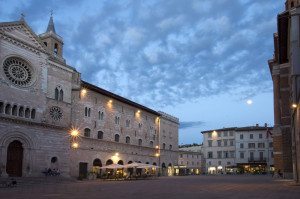
This city’s historic center includes important churches and noble palazzi. Visitors should stop at the Duomo, with its splendid Romanesque facade, the Palazzo Comunale, and the Palazzo Trinci, home of the Museo della Città (Municipal Museum). The Romansque Santa Maria Infraportas Church and the Palazzo Orfini, where the first edition of Dante’s “Divine Comedy” was printed, are also worth a visit.
On the corner of the facade of Foligno’s Cathedral, facing Piazza della Repubblica, a plaque commemorates one of the most famous events in Francis’ life story: in 1205, the young saint sold his father’s cloth and horse in this square to earn the funds necessary to restore the small San Damiano church (FF 333-334; 1039; 1415). The church of San Francesco was built in the 19th century on the spot where there was once a small chapel in which Francis would often stop when traveling to and from Assisi. Foligno is also home of the Santuario della Beata Angela, a Franciscan mystic of the third-order who lived following the examples of Francis and Christ. Near Foligno, a number of cities conserve monuments to Francis’ passage and can be visited in side trips, including Cannara (FF 1846; 3277), Pian d’Arca (FF 1206) and Bevagna (FF 424-425).
Source: “La via di Francesco” – Edizioni San Paolo S.r.l.
© FRANCESCO'S WAYS | Privacy Policy | Crediti
